The Bernese Mountain Dog is a large Swiss farm dog breed with a black-tricolor coat color. Learn more about the variation in Bernese Mountain Dog colors.
Bernese Mountain Dog Color Chart
An overview of Bernese Mountain Dog colors and their genetics.
| B/B D/D black eumelanin | medium-high red intensity | high red intensity |
| E/E wild type ky/ky wild type at/at tan points + white markings |  Black Tan & White black-based tan point and white |  Black Rust & White black-based tan point and white |
Bernese Mountain Dog Coat Colors Overview
The breed standard describes all the different traits a Bernese Mountain Dog should have.
The major kennel clubs often use their own standards provided by their affiliated breed club. These standards are usually similar in their general outline but can differ in details like coat color.
Let’s see what different clubs have to say about the accepted colors of Bernese Mountain Dogs[1-3]:
| AKC | FCI | KC | |
|---|---|---|---|
| Black Rust & White | ✅ | (✅) | (✅) |
| Black Tan & White | ✅ | (✅) | (✅) |
| Black Tricolor | (✅) | ✅ | ✅ |
Brackets indicate color names that are not mentioned in the breed standard without excluding them.
Standard Bernese Mountain Dog Coat Colors
Let’s have a closer look at the different Bernese Mountain Dog colors:
Black Tricolor Bernese Mountain Dog

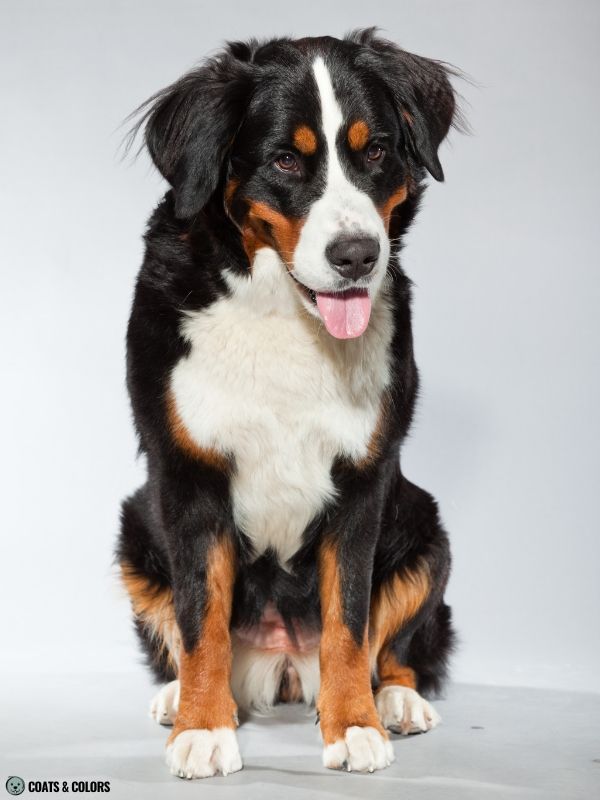

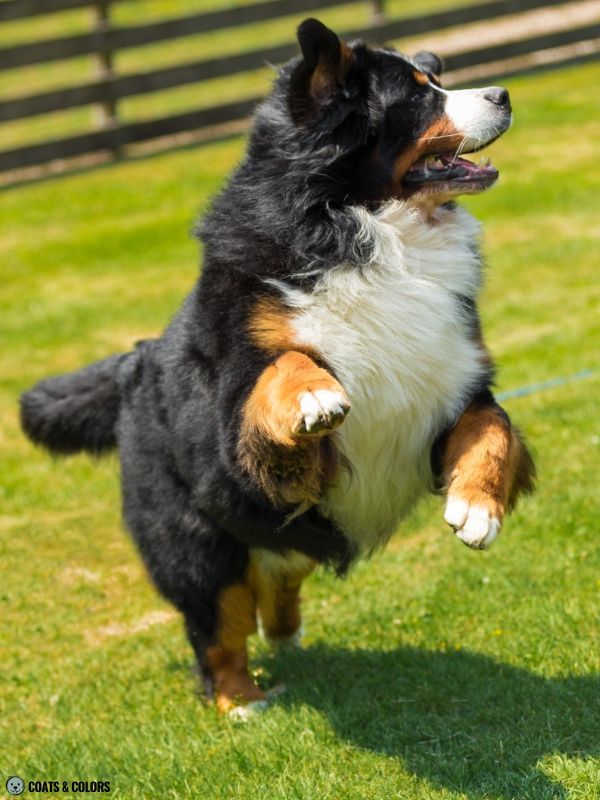
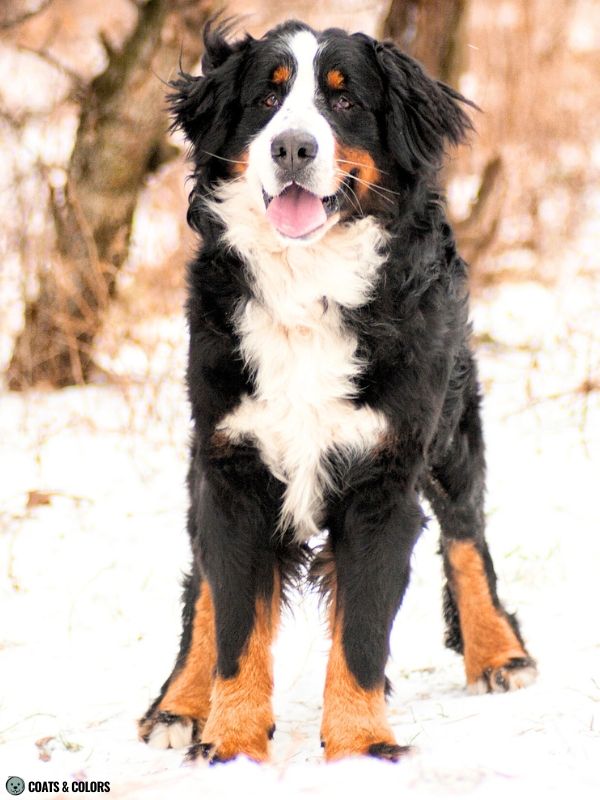
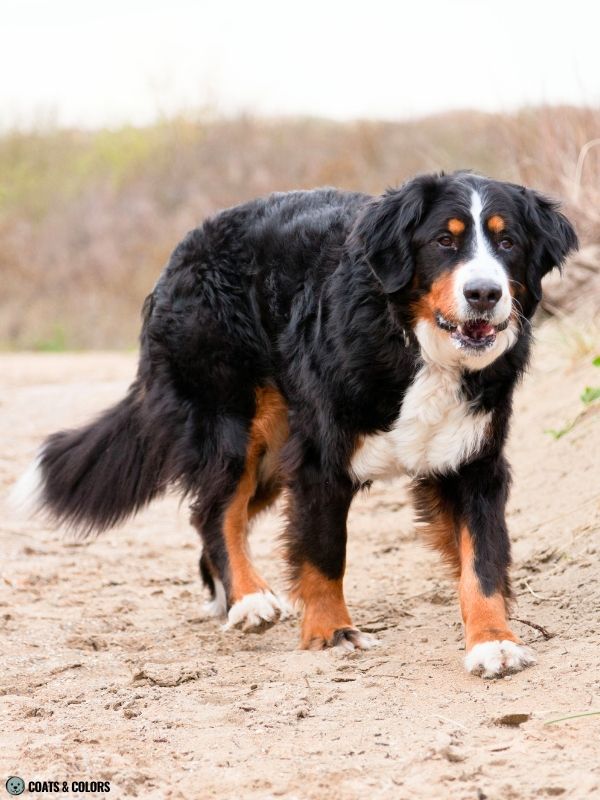
All Bernese Mountain Dogs are black and tan (E/E ky/ky at/at) with white markings. This combination is called black tricolor, the only accepted pattern in this breed (and all the other Sennenhunde).
Their tan markings have a rich reddish color, often referred to as “rust“.
The distribution of white markings in BMDs suggests they have some kind of whitehead pattern. They always have white on their chest and muzzle and can have white on their paws and tail tip.
“The Bernese Mountain Dog is tri-colored. The ground color is jet black. The markings are rich rust and clear white.”
AKC Breed Standard
“Jet black main colour with rich tan markings […] and with white markings […]“
FCI Breed Standard
Bernese Mountain Dog Coat Color Genetics
A Bernese Mountain Dog gets its three colors from eumelanin and phaeomelanin pigment or a lack of pigment which causes white markings in his coat.
These are the genes that occur in the Bernese Mountain Dog population:
| E-LOCUS | E = normal pattern e = recessive red |
| K-LOCUS | ky = wild type, enables normal pattern |
| A-LOCUS | at = tan points (ASIPBB, VP2-HCP3)[5] |
| RED INTENSITY | tan rust |
| B-LOCUS | B = black eumelanin b = brown eumelanin |
| D-LOCUS | D = normal eumelanin |
| S-LOCUS | S = solid |
| M-LOCUS | m = non-merle |
Bernese Mountain Dog Pattern
The A locus, K locus and E locus control all basic pigment distribution patterns.
They tell pigment cells when and where to make either eumelanin or phaeomelanin.
Bernese Mountain Dogs only have one accepted pattern, their color variety is very limited.
-
at/at-
ky/ky-
E/E-
tan point
-
-
-
A Locus
All Bernese Mountain Dogs are fixed for a tan point pattern (at/at).
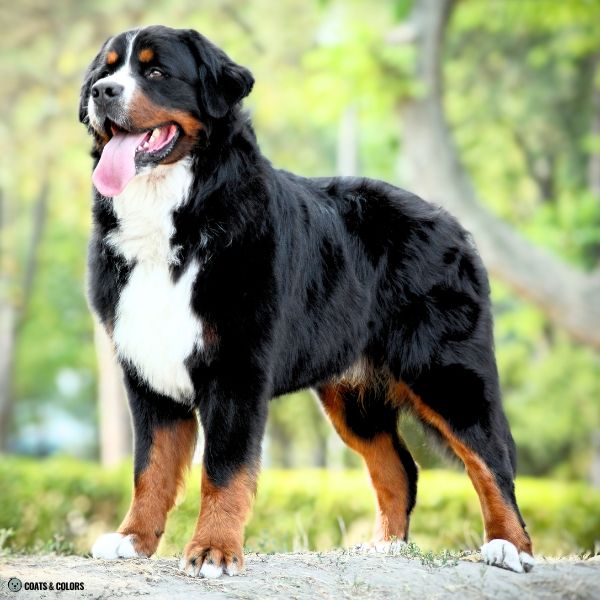
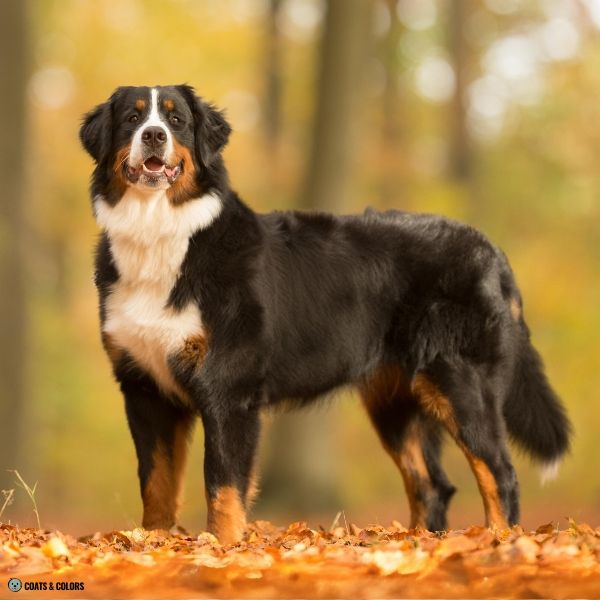

This causes their solid black coat with distinct phaeomelanin markings. These markings are always in the same locations across all breeds. Their breed standards still define tan placement.
Dogs should have a jet black coat without pale roots or intermingled tan hairs. The FCI also lists “black coat with a touch of brown or red” as faulty color, maybe they mean sunbleaching?
“Rust appears over each eye, on the cheeks reaching to at least the corner of the mouth, on each side of the chest, on all four legs, and under the tail.”
AKC Breed Standard
“[…] tan markings on the cheeks, above the eyes, on all four legs and on the chest […]”
“Disqualifying Faults: […] Other than tricoloured coat.“
FCI Breed Standard
K Locus
These dogs can express their A locus pattern.
They all have two copies of the wild type K locus (ky/ky)
E Locus
Bernese Mountain Dogs have a homozygous E/E genotype.
This is required for a normal expression of their tan point pattern.
Eumelanin Colors
All Bernese Mountain Dogs are fixed for black eumelanin (B/B).
Combined with their tan point pattern, this gives them a black & tan coat color.

“Any ground color other than black is a disqualification.”
AKC Breed Standard
“Disqualifying Faults: […] Other main colour than black“
FCI Breed Standard
In the past, a very small number of brown carriers (B/b) produced the odd brown-tricolor (b/b) puppy.
Phaeomelanin Intensity
All Bernese Mountain Dogs have a rich reddish color in their tan markings.
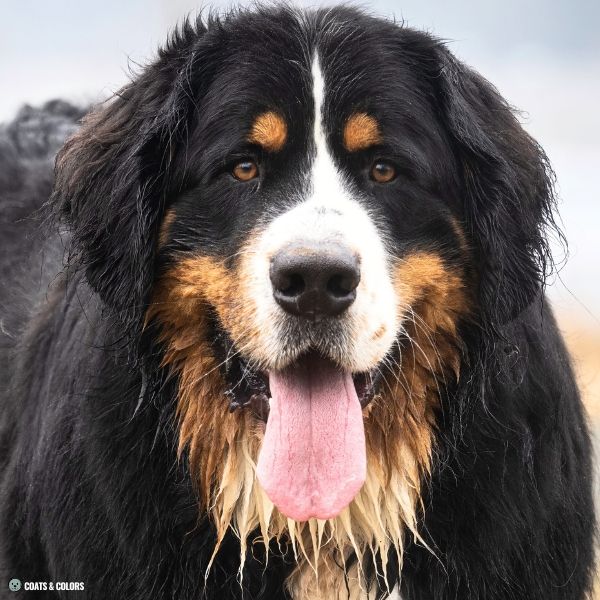

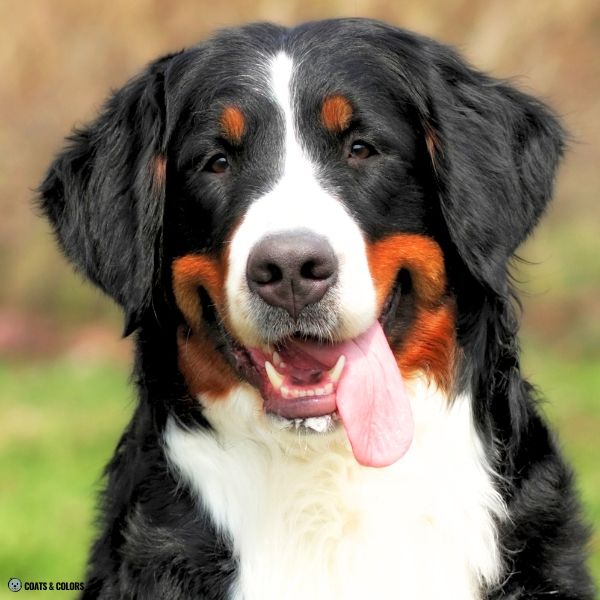
The phaeomelanin intensity is what makes the difference between the “Black, Rust & White” and a “Black, Tan & White” color with one having a just slightly more intense color than the other.
“The markings are rich rust […]”
AKC Breed Standard
“Jet black main colour with rich tan markings on the cheeks, above the eyes, on all four legs and on the chest […]”
FCI Breed Standard
“Jet black, with rich reddish-brown on cheeks, over eyes, on all four legs and on chest. […]”
KC Breed Standard
The KC calls the rust markings a “reddish-brown”. I’m not a fan since this does not reflect color genetics terms where “brown” is always reserved for chocolate-colored eumelanin.
White Spotting
All Bernese Mountain Dogs have white markings. Their breed standards place great emphasis on how much white these dogs should have and where they should have white markings.
White is the third “color” that turns their black & tan pattern into a black-based tricolor pattern.
Some white on the muzzle, a blaze and a white chest patch are essential standard markings.
But size and symmetry of face markings can vary a lot between individual dogs.
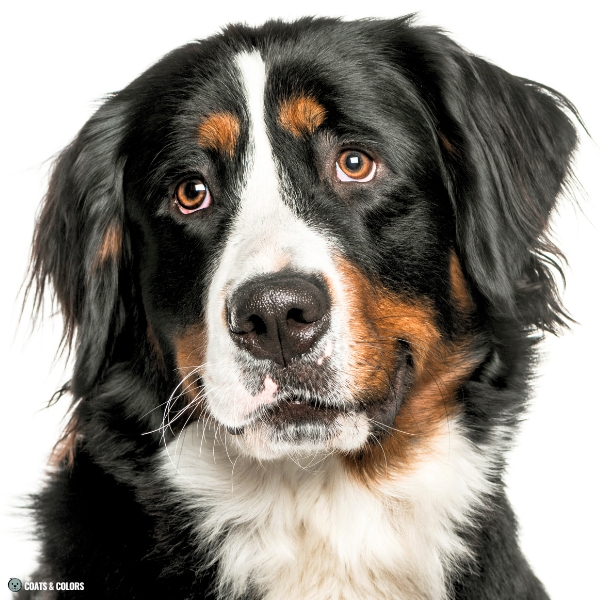

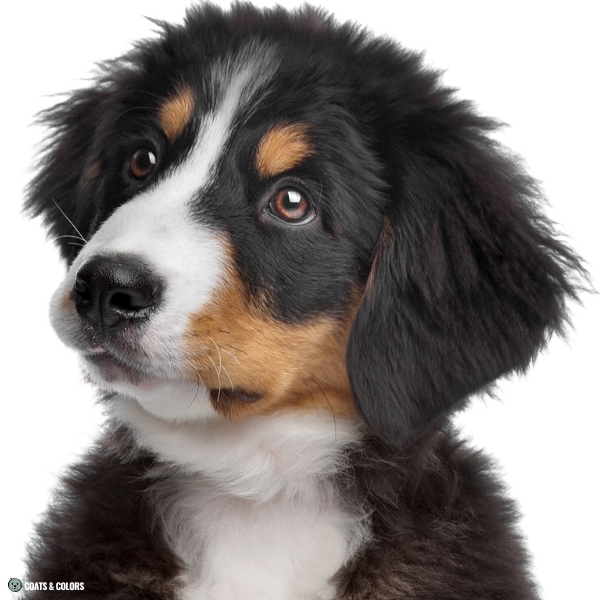


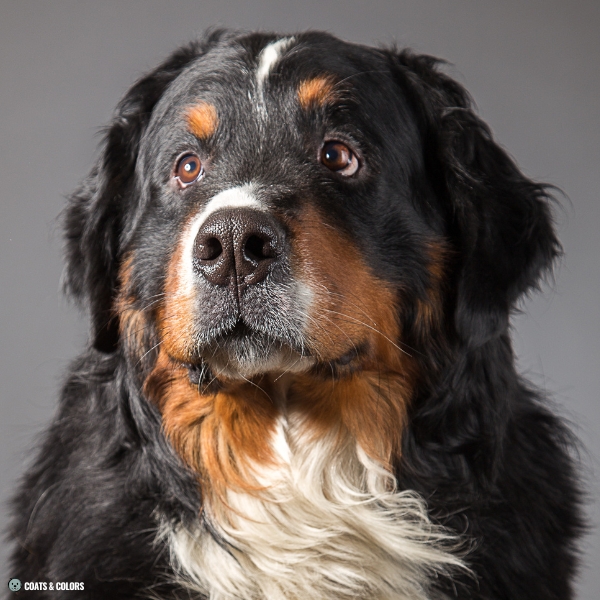
The FCI standard specifies that the white on the muzzle (called a “muzzle band” in Bernese Mountain Dogs) should not extend beyond the corners of the mouth.
BMDs should have a blaze that can reach quite far up the face. However, the blaze should not be wide enough to touch the red pips above each eye.

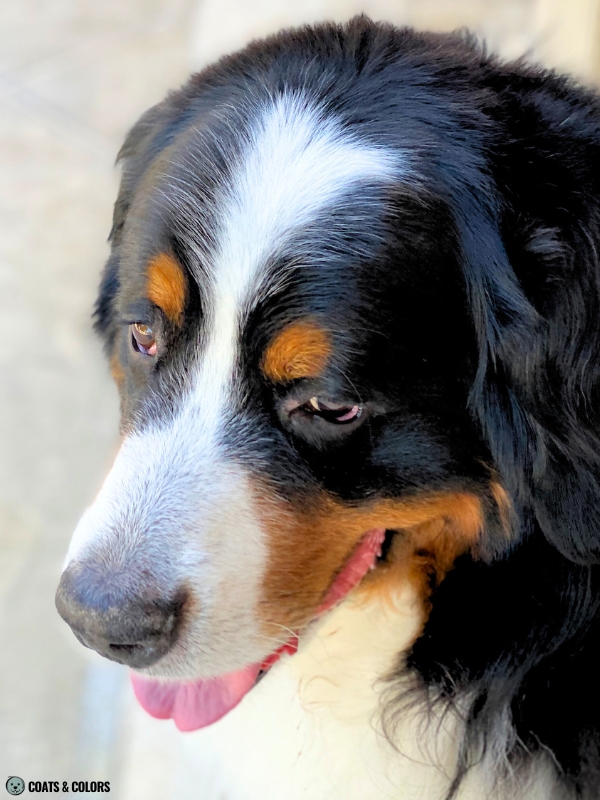


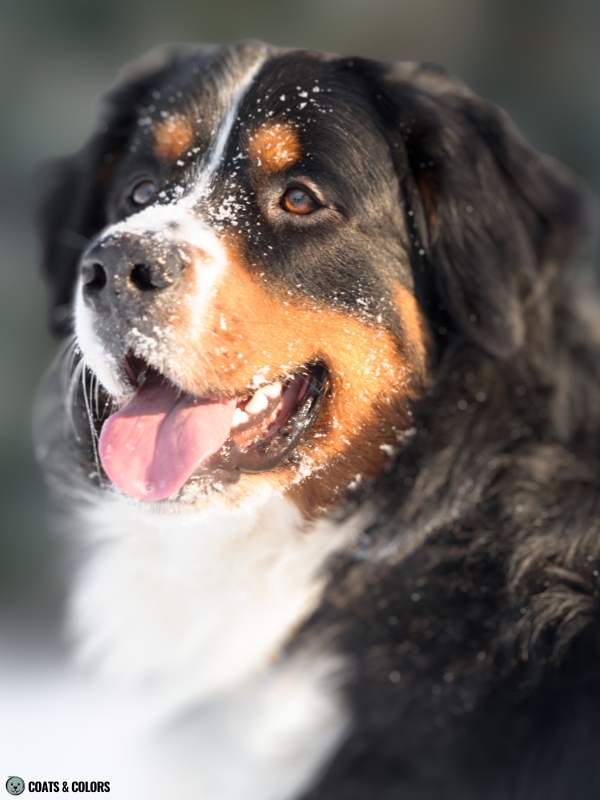

Bernese Mountain Dogs are not supposed to have a white collar. The FCI standard tolerates a small white patch on the nape of neck if it is less than 6 cm in diameter.
“There is a white blaze and muzzle band. “
AKC Breed Standard
“the blaze should not reach the tan markings above the eyes, and the white muzzle band should not extend beyond the corners of the mouth.“
FCI Breed Standard
Their white chest markings should form an “inverted cross“.

But this may not be fully visible on an adult dog with a lot of long hair growing down the chest.
White should have visible tan on each side of the chest. This indirectly means that the white chest patch should not be so large that it covers the entire tan markings on the dog’s chest.
“A white marking on the chest typically forms an inverted cross. “
AKC Breed Standard
“Moderately broad, unbroken white marking on throat and chest.”
FCI Breed Standard
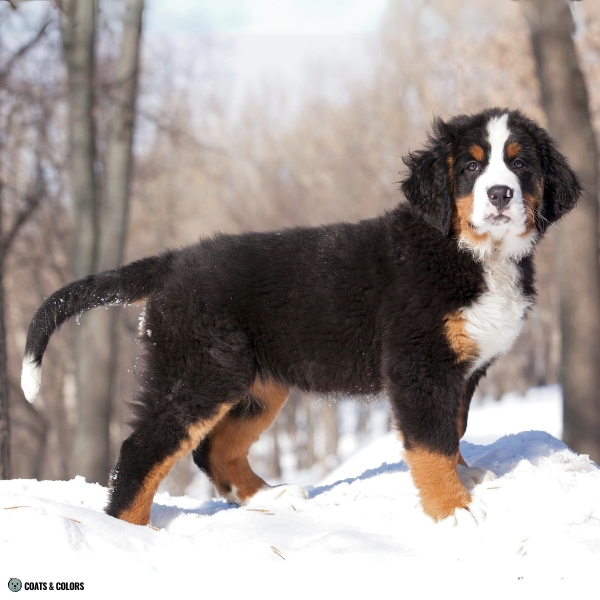
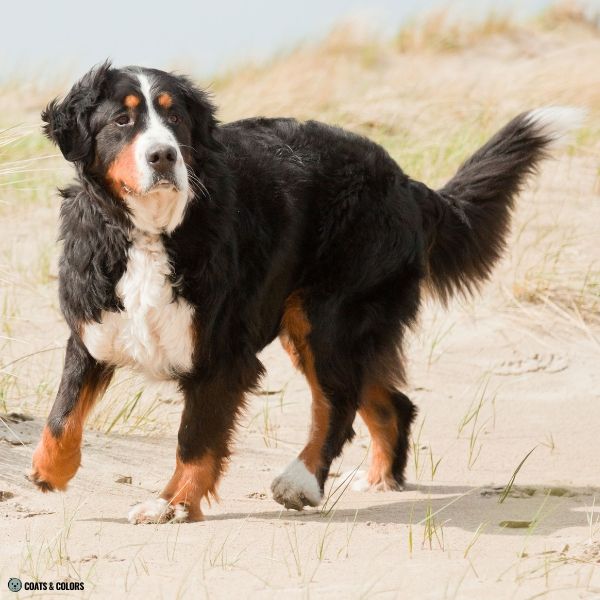
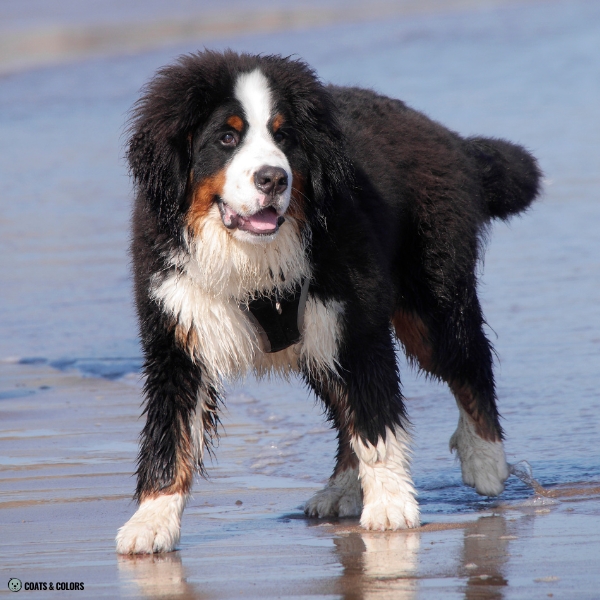
The tip of the tail and the paws can be white. But absence of white on the feet or tail is not a major problem in this breed. In fact, solid paws are expected to happen in some dogs with a whitehead pattern.
Quite the opposite, white legs are not accepted and white is not meant to extend from the feet higher than the pasterns. The FCI even discourages “boots” that reach beyond half-way of the pasterns.
“The tip of the tail is white.“
“White on the feet is desired.”
AKC Breed Standard
“Desirable: white feet, white tip of tail.”
FCI Breed Standard
Interestingly, BMDs usually test as solid on the S locus (S/S).
Their pseudo-Irish marking pattern neither comes from piebald nor are they real Irish markings (real Irish-type spotting gives rather minimal white on its own).
Instead, all of these dogs show a type of whitehead. And they have been selected for a moderate amount of white and as symmetrical a white pattern as possible.
The whitehead trait differs from normal white spotting in its progression pattern.
The whitehead in this breed becomes particularly evident in dogs with a lot of chest and head white but little to no white on their paws. Neither white spotting from the S locus nor Irish spotting does that!

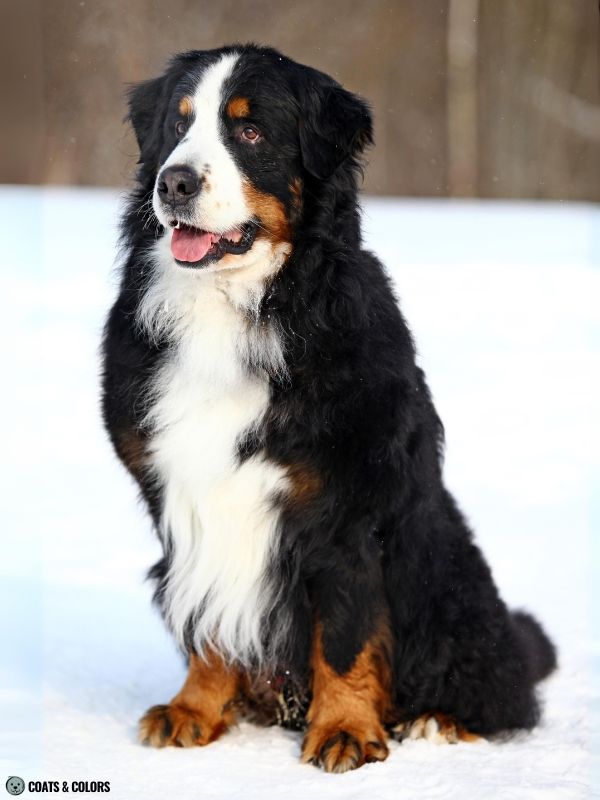
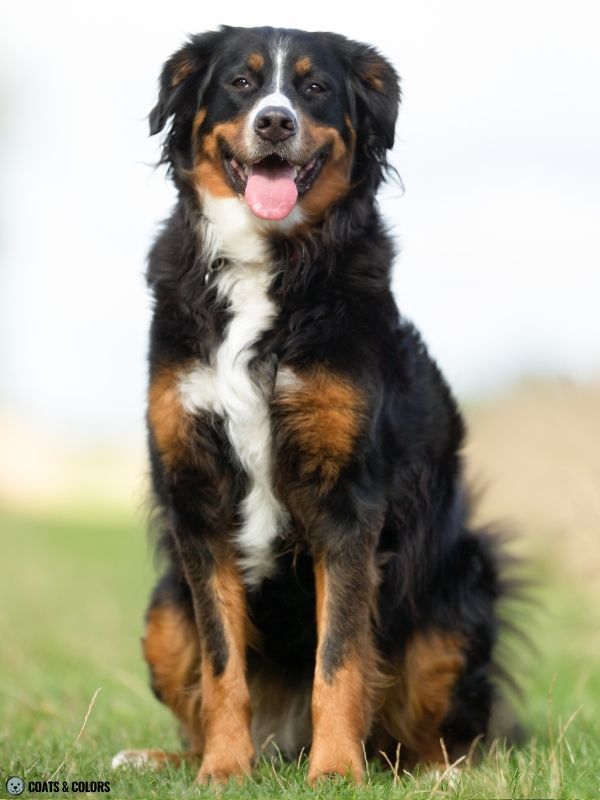
Since white markings happen when something disturbs the migration of living pigment cells. There is always some randomness to all white patterns.
Although the majority of BMD have markings that fit their breed standard, a whitehead phenotype will never be fully predictable. Face and body markings can vary a lot even between siblings.
In all breed standards, the symmetry of white markings is described as a desirable quality. And “disturbingly asymmetrical white markings on the head and/or chest” are considered a problem.
And a very small number of BMDs end up with less or more white than expected. Too much white can cause a white collar or a wide blaze, some white over the eyes, and even blue eyes in more extreme cases.
The FCI breed standard lists both “black ticks and stripes within the white on the chest” and “dirty white with strong spots of pigmentation” as a fault. Sounds like maybe some dogs in the past had ticking?
Coat Color Genotypes
There is only one pattern in Bernese Mountain Dogs:
| Color Term | Pattern |
|---|---|
| Black Tricolor black-based tan point pattern + white | B/B D/D E/E ky/ky at/at S/S + rich phaeomelanin intensity + white markings |
Bernese Mountain Dog Eye Colors
Bernese Mountain Dogs have black eumelanin (B/B D/D).
They all have brown eyes which can be a lighter or darker shade of brown.

Extended white on the face can disturb eye pigmentation and cause blue eyes.

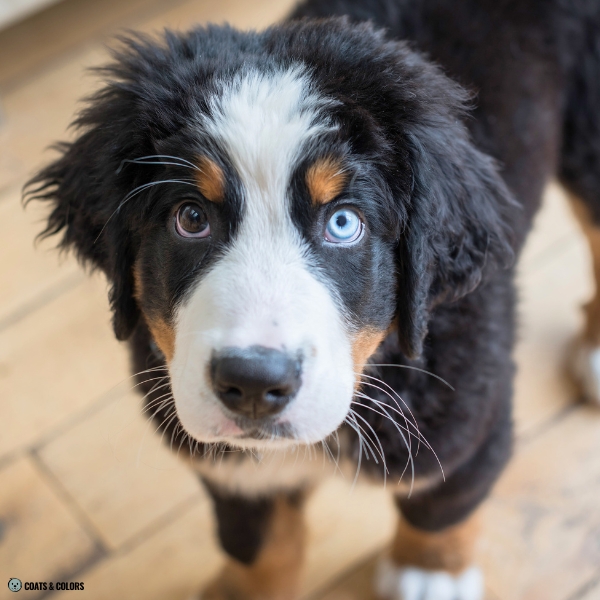

“The eyes are dark brown […]“
“Blue eye color is a disqualification.”
AKC Breed Standard
“Disqualifying Faults: […] One or two blue eyes (wall eye).”
FCI Breed Standard
Bernese Mountain Dog Nose Colors
Their black eumelanin gives all BMDs a black nose.
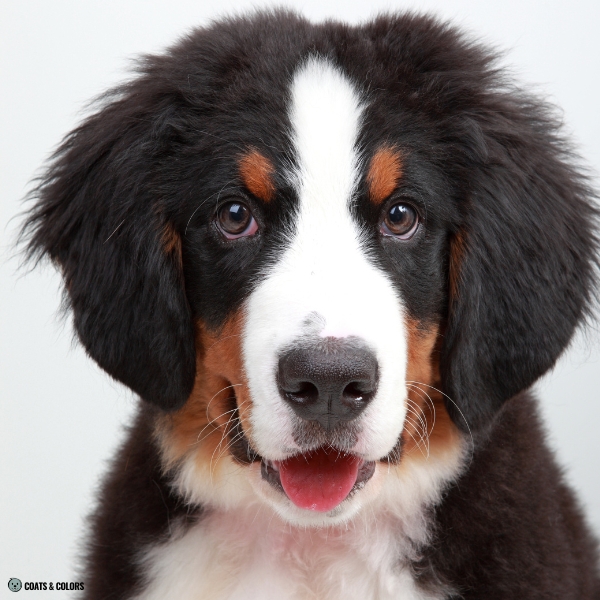


It also causes them to have black pigment on their lips, eye rims, paw pads, or nails.
Some dogs may have weak nose pigment, but their nose is still black.
“The nose is always black.“
AKC Breed Standard
“Nose: Black“
FCI Breed Standard
Bernese Mountain Dog Mismarks and Fancy Colors
All BMDs have the same pattern, they are fixed for many of all color traits.
“Disqualifications: Any ground color other than black”
AKC Breed Standard
“Disqualifying Faults:
Other than tricoloured coat.
Other main colour than black”
FCI Breed Standard
However, many faulty colors happen by accident due to recessive alleles.
Dogs with just one copy of a recessive trait are carriers and may pass on these traits over generations. Breeding two carriers can lead to homozygous recessive puppies which will then express the trait.
The AKC lists three alternative patterns for this breed:
Black & Rust Bernese Mountain Dog
This could refer to a black and tan pattern without white markings.
Today, BMDs seem to fixed for whatever causes their white markings. The chances of getting a solid-patterned puppy without any amount of white from two Berners seem to be extremely small.
The ancestors of this breed regularly came with no white in their pattern (or more white such as a white collar). But both the piebald variant and solid coat have been selected against in the past.
Black & White Bernese Mountain Dog
There are two ways to produce a solid black coat, recessive black (a/a) or dominant black (KB/-).
To my knowledge, there is no recessive black in this breed.
One option to get a black and white BMD-lookalike dog is to cross them with a KB/KB breed like the Newfoundland and then backcross to BMD while selecting for black coat.
Apparently, there has been some Newfie introgression in the earlier days of the breed[6]. And their dominant black variant (KB/-) will override the tan point pattern.
Rust & White Bernese Mountain Dog
The recessive e variant occurs in this breed at very low frequencies.
Breeding two carriers (E/e) can give a yellow Bernese Mountain Dog (e/e). In this pattern, all pigmented patches will not be able to produce black pigment and will be solid red.
Red and white was a normal pattern for Swiss farm dogs. But the creators of this breed decided to select for patterned tricolor coat which meant they selected against the recessive e variant.
If a dog is mostly red but has hints of black shading or a black mask he can’t be e/e.
In this case, the dog is likely sable (Ay) which is dominant to the tan point (at) variant which means one of the parents had to be Ay/- which is not possible from two standard-colored Bernese parents (at/at).
Merle Bernese Mountain Dog
There is no merle in purebred Bernese Mountain Dogs!
Merle is a dominant trait and classic merle will be quite obvious in a black tri coat. Some breeders introduced merle by crossbreeding (say with a Merle Bernedoodle) and then backcrossing to BMD.
Bernese Mountain Dog Coat Types
The Bernese Mountain Dog is a long-haired breed.
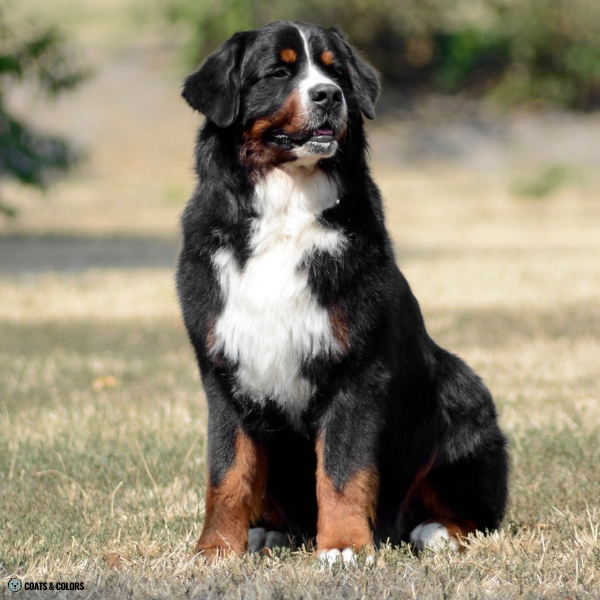
They have a medium-long coat with shorter hair on their face and lower legs.
“The coat is thick, moderately long and slightly wavy or straight. “
AKC Breed Standard
“Long, shining, straight or slightly wavy.”
FCI Breed Standard
Other Coat Types in Bernese Mountain Dog
Some dogs seem to get their “slightly wavy coat” from a curly variant.
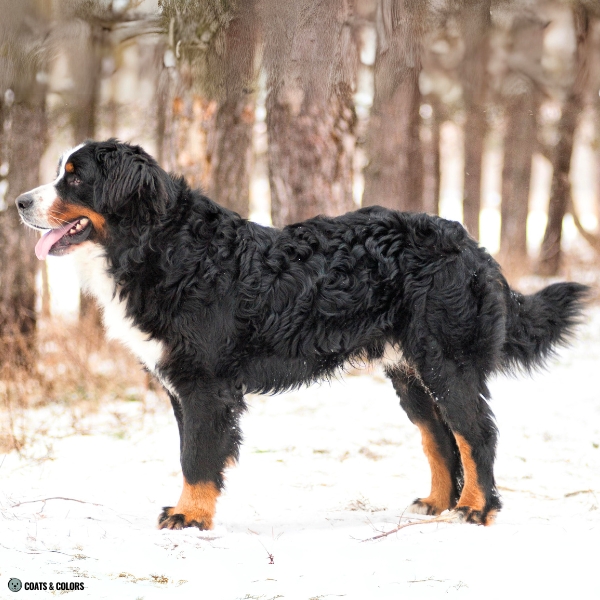
Breeding two “curly carriers” (Cu/N) can result in homozygous (Cu/Cu) puppies. This is a trait with incomplete dominance where homozygous dogs will express a lot more curly coat than dogs with just one copy.
“Extremely curly or extremely dull-looking coats are undesirable. “
AKC Breed Standard
“Faults: […] Distinctly curly coat.”
FCI Breed Standard
Learn More
Links
[1] American Kennel Club (AKC): Official Standard of the Bernese Mountain Dog (pdf)
[2] Fédération Cynologique Internationale (FCI): Bernese Mountain Dog Breed Standard
[3] The Kennel Club (KC): Bernese Mountain Dog Breed Standard
[4] Dreger et al. (2019). True Colors: Commercially-acquired morphological genotypes reveal hidden allele variation among dog breeds, informing both trait ancestry and breed potential. PLoS ONE 14(10): e0223995. https://doi.org/10.1371/journal.pone.0223995
[5] Letko et al. Genomic Diversity and Runs of Homozygosity in Bernese Mountain Dogs. Genes 2023. https://doi.org/10.3390/genes14030650
[6] Rita Hörter: Bernese Mountain Dogs (pdf)

Hi! I’m Steffi. I am a biologist and a big time dog nerd. You are curious about coat color genetics? You’ve come to the right place! Read more.

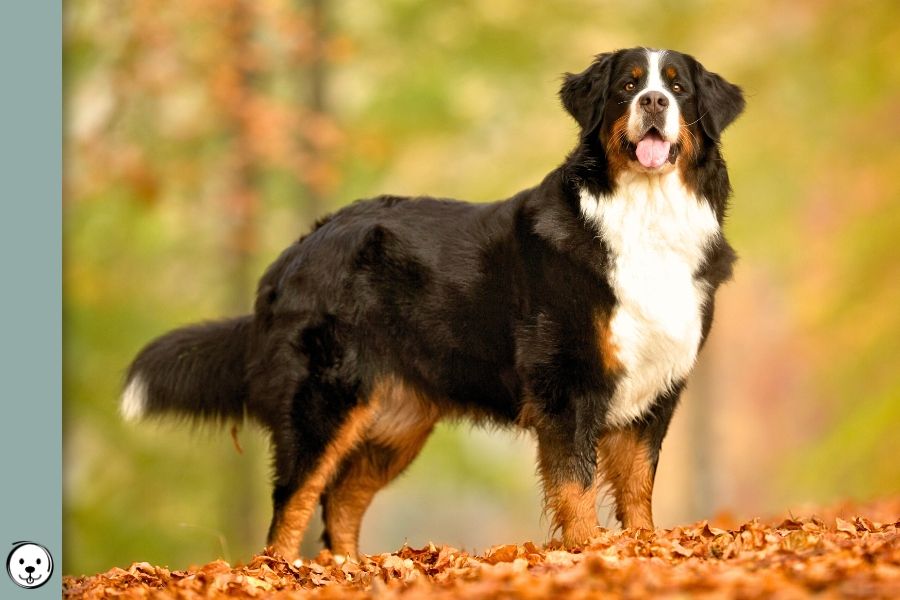

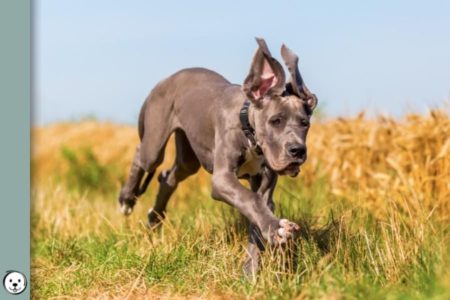



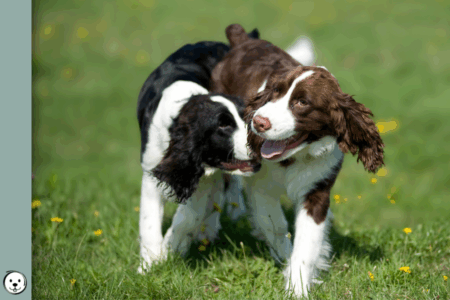
5 thoughts on “Bernese Mountain Dog Coat Colors”
Comments are closed.